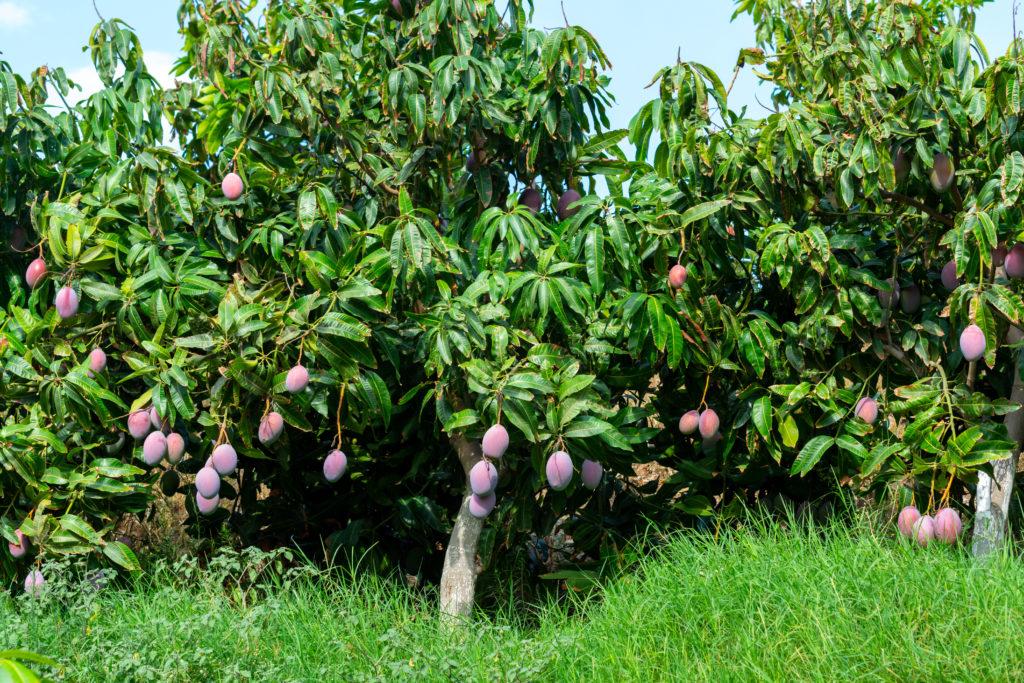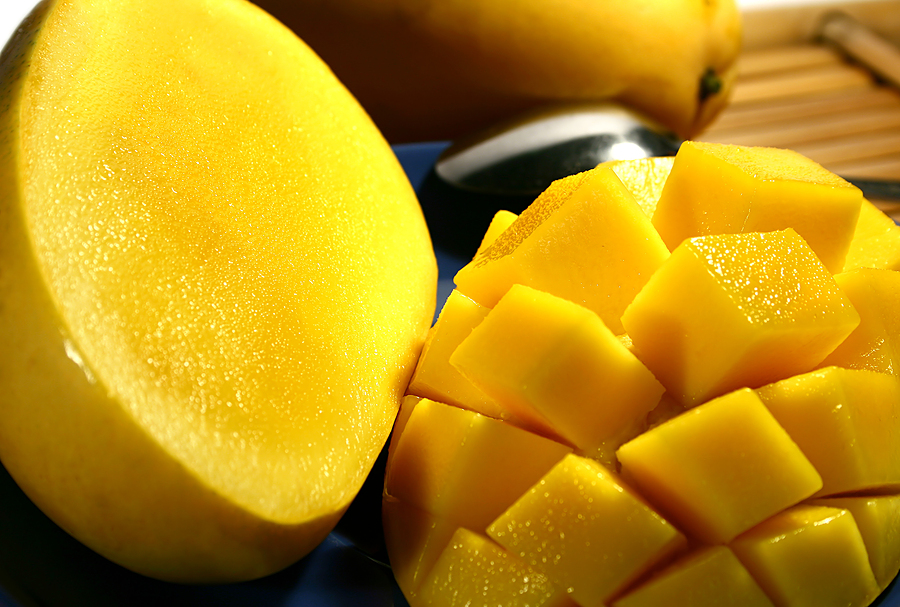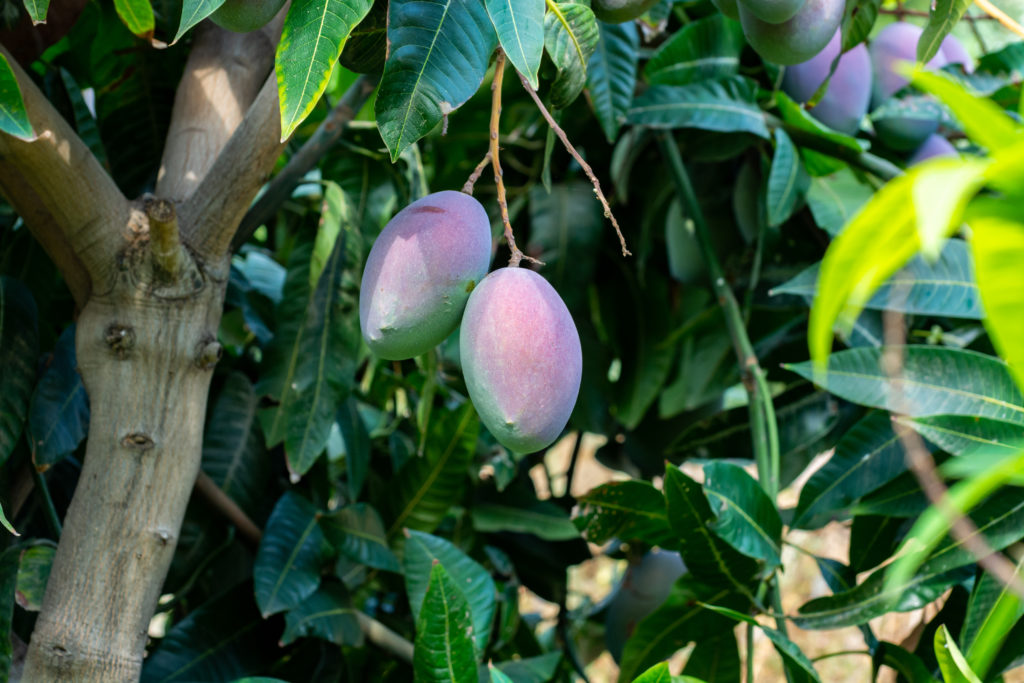Mango trees can grow in the home garden.
The mango is native to southern Asia and eastern India. Mangoes are among the most widely cultivated fruits in the tropics.
There are more than 500 hundred cultivars of mango. Some can grow more than 100 feet tall and more than 30 feet wide. Smaller dwarf cultivars that are ideal for home gardens grow just 4 to 8 feet tall. ‘Tommy Atkins’ is the most widely grown mango worldwide. It is 10 to 12 feet tall at maturity.
Related article:

Mango fruit can vary in size and sweetness and in skin and flesh color. The fruit can be round to oval, weigh from 6 ounces to 5 pounds each and have a skin that may be green with red patches or yellowish-green with rosy parts. As the fruit ripens the warm red, orange, and yellow shades intensify and the green fades.
The color of mango flesh color can be pale yellow, gold, or orange. The flavor of mango is reminiscent of peach, apricot, and papaya. The fruit must be peeled before eating and a large flat seed in the middle must be cut away from the flesh.
Mangoes can be eaten raw, sliced, or cubed. Mango can be eaten alone or with other fruits. Mango can be used in compotes, cakes, and tarts; it can be pureed and used as a base for sherbets, whips, ice cream, beverages, and dessert sauces. Underripe mangoes can be made into mango chutney and mango pickles.
Here is your complete guide to growing mango.
Best climate and site for growing mango
- Mangoes must grow in a frost-free climate. Mangoes require warm, dry weather to set fruit. Mangoes like heat they resent cool temperatures.
- Mango flowers and young fruits will be damaged or killed by temperatures below 40°F even for an hour or two. Young trees will be damaged if the temperature drops below 30°F; mature trees will be damaged if the temperature drops to 25°
- Plant mangoes in full sun.
- Plant mangoes in deep compost-rich, well-drained soil. Deep soil is necessary to accommodate the mango’s deep taproot. Avoid planting mangoes in heavy clay soil or soil that is wet.
- Mangoes prefer a soil pH of 5.5 to 7.5.
Choosing the right mango to plant
- Mango cultivars that grow in one climate may not grow well in another. All mangoes require tropical or subtropical growing climates; some can grow in humid climates; some grow only in dry climates
- Consult the nearby Cooperative Extension Service, Master Gardener group, or local fruit growers’ group to learn which cultivars will grow well where you live.
- Consider the height of the cultivar at maturity; dwarf varieties are best suited for most home gardens.
- ‘Tommy Atkins’ is the most widely grown mango worldwide. It is 10 to 12 feet tall at maturity.
- ‘Alphonso’ is widely considered the best-flavored mango; it grows 10 to 15 feet tall.
- Mangoes are usually sold as grafted saplings.
Mango pollination
- The mango inflorescence is a collection of as many as 2,000-minute flowers. Most do not produce pollen, but a few are perfect flowers containing both male and female parts; these flowers can self-pollinate and produce fruit without cross-pollination from another tree. Pollen will not drop in high humidity or rain. Fertilization will not occur when night temperatures are below 55°
- Mangoes can be pollinated by flies, hoverflies, and occasionally by honeybees.
Mango yield
- A mature mango tree can produce 100 to 200 fruits or more each year depending on the cultivar.
Spacing mango
- There are hundreds of mango cultivars. Some can grow more than 100 feet tall and more than 30 feet wide. There are much smaller cultivars and even dwarf cultivars that grow between 4 and 15 feet tall. Consider the size at maturity of the cultivar you want to grow and space trees accordingly.

Planting mango
- Prepare a planting site in full sun that is sheltered from a prevailing breeze or wind. A south-facing wall that can collect and radiate solar heat is a good spot in cooler locations.
- Work well-rotted compost or manure into the soil.
- Dig a hole half again as deep and twice as wide as the tree’s roots. Add a cupful of all-purpose fertilizer to the bottom of the hole.
- Put a tree stake in place before planting. Drive the stake into the ground to the side of the hole to at least 2 feet deep. Mature mangoes are deep-rooted but young trees need to be staked at planting time.
- Set the plant in the hole so that the soil mark from the nursery pot on the stem is at the surface level as the surrounding soil. Spread the roots out in all directions.
- Re-fill the hole with half native soil and half aged compost or commercial organic planting mix; firm in the soil so that there are no air pockets among the roots. Water in the soil and create a modest soil basin around the trunk to hold water at watering time.
- Secure the tree to the stake with tree ties.
- After planting, water each tree thoroughly and fertilize with a high-phosphorus liquid starter fertilizer.
Container growing mango
- Dwarf and semi-dwarf mangoes can be grown in containers.
- Choose a container at least 24 inches wide and deep that is well-drained. Fill the container with a well-draining potting mix formulated for citrus or palms.
- Keep the soil just moist during the growing season, but not wet. Wet soil will cause roots to rot.
- Mangoes in containers can be grown indoors but there must be ample sunlight for the fruit to ripen.
Mango care, feeding, and watering
- Keep the soil evenly moist from flowering to harvest. Water as necessary to moisten the soil, but the soil should not remain wet. Allow the soil surface to dry to a depth of 2 to 3 inches between waterings.
- Stop watering for about two months after harvest to initiate a new bloom and growth cycle.
- Feed mangoes three times during the growing season with an organic citrus fertilizer blend, slightly high in nitrogen. Fish emulsion can be used to fertilize mango trees. Do not feed mangoes after midsummer as fruits begin to ripen.
- Protect young trees from frost. Place plant blankets on trees or build a frame around the tree and drape clear plastic sheeting over the frame. Place electric lights inside the frame to provide additional warmth.
Pruning mango
- Mangoes require little pruning.
- Prune to establish strong scaffold branches in the first three years after planting.
- Following years, prune away broken or diseased branches, and prune away suckers that grow from the graft.
- Removing some flower clusters during seasons of heavy blooming may alleviate alternate bearing.
- Prune to control size in late winter or early spring.

Thinning mango
- Thin heavy fruit set so that the tree will bear fruit again the next season; if a heavy crop is left to ripen the tree will tend to bear small crops in alternate years.
Harvesting and storing mango
- Mango trees bear fruit about six years after seed sowing. Saplings usually take 3 to 5 years to bear fruit.
- Mango fruit matures 100 to 150 days after flowering.
- Let fruit ripen on the tree for the best flavor.
- Ripe fruit will turn to its mature color and become soft to the touch similar to a peach.
- Fruit will ripen off the tree at room temperature. Place the fruit stem end down to ripen Cover the fruit with a cloth so that it does not shrivel
Propagating mango
- Grafting is the most reliable means of propagating the mango. It consists of transferring a piece of a mature, bearing tree (scion) to a separate seedling tree (rootstock), forming a permanent union. The scion forms the canopy of the tree, while the rootstock forms the lower trunk and roots. ‘Turpentine’ and ‘Number 11’ are the most widely used rootstocks.
- Mangoes can be grown from seeds, but it will take about six years to bear fruit. Plant seeds from mature fruits that have not been dried or frozen. About ¼ inch of the seed should protrude above the soil when planted. If the soil is kept at about 70°F, germination will occur in 8 to 21 days.
Mango pests, diseases, and problems
- Scale, mealybugs, and mites may attack mangoes. These sap-sucking insects can be washed off plants with a steady stream of water; they also can be sprayed with insecticidal soap or as Spinosad spray.
- Anthracnose, a fungal disease, and bacterial leaf spot can distort leaves and turn them black; treat leaves with a fungicide. Remove and dispose of diseased leaves.
- ‘Soft nose” is a physical disorder that can cause fruits to shrivel at the apex; this is likely caused by too much nitrogen in the soil.
Fall and winter mango care
- Mangoes ripen from late summer through late winter depending on the variety.
- Early-season fruit ripens in late summer to mid-autumn; mid-season fruits ripen in late autumn; late-ripening fruit ripens in midwinter to late winter.

Mango varieties to grow
All of the mango varieties listed here are suitable for home gardens; few grow taller than 10 to 15 feet.
- ‘Aloha’: from Hawaiian seed; spreading tree; light-bearer; fruit large (14-18 oz.), dull yellow covered with red; ripens in late autumn; susceptible to anthracnose; grows near the coast.
- ‘Alphonso’: Indian type; greenish-yellow to yellow skin; sweet flavor with hints of apricot and peach; grows 10 to 15 feet tall; widely considered the best-flavored mango.
- ‘Brooks’: dwarf tree; fruit medium to large (10-20 oz.), kidney-shaped, green with yellow shoulder, rather fibrous; ripens in winter; resistant to anthracnose; for greenhouse and containers.
- ‘Cambodiana’: Philippine type; fruit small to medium, elongated ovate, yellow-green; juicy, flavor acid; ripens summer to autumn; will grow in the greenhouse.
- ‘Carabao’: Philippine type; fruit medium (10 oz.), elongated, kidney-shaped, light green blushed yellow; seed very large; flesh stringy, acid flavor, juicy; ripens early midseason; will grow in the greenhouse.
- ‘Carrie’: dwarf tree; fruit varies from small to 12 oz., regular ovate, green-yellow; fiberless flesh, flavorful; ripens early; can grow in the greenhouse.
- ‘Cooper’ (syn. ‘Cooper No. 1 or 3’): spreading tree spreading, dense; fruit large (16-20 oz.), long, green; ripens late.
- ‘Costa Rica’: small fruit to 10 oz., elongated, pale green; juicy; ripens very early; a good choice for the coast.
- ‘Doubikin’: dwarf tree dwarf; large, rounded fruit; slow-growing, fruits in two years from seed; ripens; midseason; can grow in the greenhouse.
- ‘Earlygold’: upright tree; medium fruit to 12 oz., obliquely round, orange with a red blush; fiberless interior; ripens very early; resistant to anthracnose.
- ‘Edgehill’: Indian type; upright tree, hardy, vigorous; blooms early; small to medium (8-12 oz.) fruit, green with a red blush; almost fiberless; resists mildew, subject to soft nose disorder; ripens midseason.
- ‘Edward’: intermediate between Indian and Philippine forms; compact tree; medium to large, elongated fruit, yellow-green with a red blush; small seed; excellent flavor excellent; ripens early.
- ‘Fascell’: fruit medium to large, yellow with a pink blush; acid flesh acid; ripens early.
- ‘Gouveia’: upright, open tree; medium to large (10-20 oz.) fruit, long ovate; green becoming bright red; sweet, juicy, no fiber; ripens late, uneven ripening.
- ‘Haden’: Indian type; fruit large (to 24 oz.), regular ovate, yellow almost covered with red; mild flavor, little fiber; ripens early; susceptible to anthracnose and alternate bearing; can grow in the greenhouse.
- ‘Irwin’: very small tree; medium fruit (12-16 oz.) elongated, orange-yellow with a deep blush; bland flesh, fiberless; ripens mid-season; can grow in the greenhouse.
- ‘Julie’: dwarf tree, slow-growing; small fruit (6-10 oz.), flat oblong, orange; sweet, juicy, rather fibrous; ripens late; for containers and greenhouse.
- ‘Keitt’: large fruit (20-26 oz.), ovate, green; rich flesh, fiber only around seed; resists mildew; ripens late.
- ‘Kensington Pride’ (syns. ‘Pride of Bowen’, ‘Bowen Special’): medium to large fruit, almost round with pink blush; sweet flavor; fruit tends to drop at a small size; ripens midseason.
- ‘Kent’: upright tree; large fruit (20-26 oz.), regular ovate, greenish-yellow with a red shoulder; rich flavor, fiberless; ripens midseason.
- ‘MacPherson’: low branching tree; small fruit (6-8 oz.), yellow-green with red blush; good flesh; ripens midseason.
- ‘Manila’: Philippine type; dwarf tree; small fruit small (to 10 oz.), shaped long, flat, yellow; sharp flavor; subject to anthracnose; ripens early, late picked fruit best.
- ‘Mulgoba’: Origin Bombay; distinct from ancient cv. Mulgoa. Fruit medium, (16 oz.), greenhouse.
- ‘Ott’: dwarf tree; medium fruit to six inches, orange-yellow with pink blush; ripens very early.
- ‘Piña’ (syn. ‘Pineapple’): Philippine type; upright tree; small fruit (to 12 oz.), shape ovoid, orange-yellow; flavor suggests pineapple; ripens early midseason.
- ‘Pirie’ (syn. ‘Paheri’): broad, spreading tree; small fruit (8-10 oz.), almost round, yellow with red blush; rich flavor, juicy, fiberless; alternate bearing; blooms every 18 months; ripens early midseason; can grow in the greenhouse.
- ‘Reliable’: broad, slow-growing tree; fruit size varies (from 10-20 oz)., shape oblong, yellow blushed red; susceptible to anthracnose, soft nose; long ripening season, autumn through winter.
- ‘Sensation’: broad, rounded tree; small, round fruit, yellow with red blush; ripens late.
- ‘T1’: low, spreading tree; medium to large fruit, 6-8 inches, shape broad oval, green with red blush, fiberless; subject to anthracnose, resists mildew, soft nose; ripens late midseason; will grow in containers.
- ‘Thomson’ (syn. Thomson Large Seedling): spreading tree; small to medium fruit, (6-12 oz.), yellow; resists mildew; ripens early, ripens well indoors if picked prematurely.
- ‘Tommy Atkins’: medium to large fruit (16 oz.), with thick skin, regular ovate, orange-yellow covered with red and heavy purple bloom; firm, juicy, medium fiber, fair to good quality; flavor poor when over-fertilized and irrigated; resists anthracnose; ripens early, ripens well if picked immature.
- ‘Villaseñor’: dwarf tree; medium fruit (to 12 oz.), ovate, greenish-yellow, pink blush; mild flavor; ripens late midseason.
- ‘Winters (syn, M20222, Southland)’: Philippine type; medium fruit (to 14 oz.), smaller in the desert, yellow blushed red; subject to anthracnose, resists soft nose; ripens midseason, ripens well if picked immature.
- ‘Zill’: spreading, open tree; small fruit (8-12 oz), almost round, yellow with blush, little fiber; ripens early; grows well in a greenhouse.
Also of interest:
How to Grow Feijoa Strawberry Guava
Related articles:
Planning the Home Fruit Garden
Garden Planning Books at Amazon:
- Vegetable Garden Almanac & Planner
- Kitchen Garden Grower’s Guide Vegetable Encyclopedia
- Vegetable Garden Grower’s Guide
- Tomato Grower’s Answer Book
More fruit-growing articles:
Learn how to plant, grow, prune, and harvest your favorite fruits. Click below for all you need to know.
- Apple
- Apricot
- Avocado
- Banana
- Blackberry
- Blueberry
- Cantaloupe
- Chayote
- Cherimoya
- Cherry
- Citrus
- Clementine
- Cranberry
- Currants
- Elderberry
- Feijoa
- Fig
- Gooseberry
- Grape
- Grapefruit
- Guava
- Kiwifruit
- Kumquat
- Lemon
- Lime
- Loquat
- Mandarin
- Mango
- Melon
- Mulberry
- Muskmelon
- Nectarine
- Olive
- Orange
- Papaya
- Passion Fruit
- Peach
- Pear
- Persimmon
- Pineapple
- Pineapple Guava
- Plantain
- Plum
- Pomegranate
- Pumpkin
- Quince
- Raspberry
- Strawberry
- Tangelo
- Tangerine
- Tangor
- Watermelon















